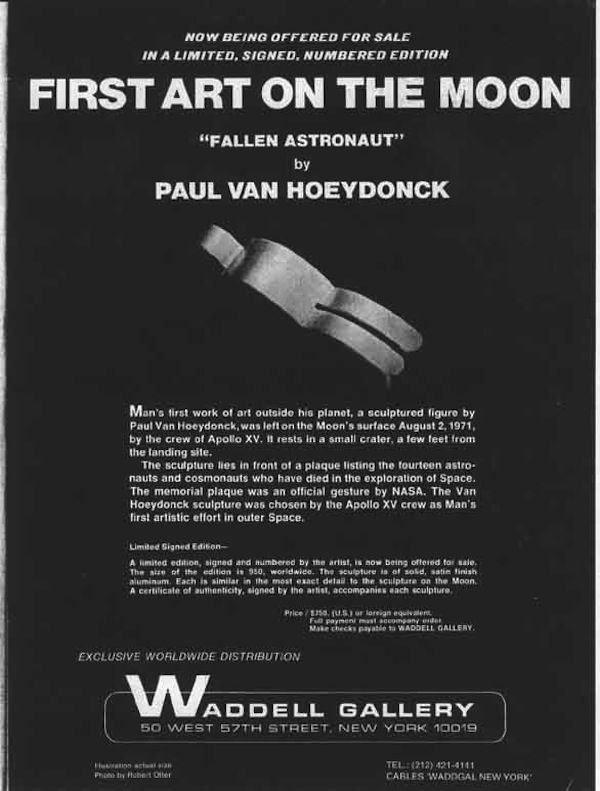There Is a Sculpture on the Moon Commemorating Fallen Astronauts
The crew of Apollo 15 placed a small aluminum sculpture on the moon to memorialize those astronauts had died

Image: NASA
The playwright Wilson Mizner once said, “Art is science, made clear.” When that science is space exploration, clarity involves acknowledging the serious danger of the enterprise and the possibility of death. Around 20 astronauts have lost their lives in the line of duty. In 1971, that number was 14, and in honor of those space travelers, the crew of Apollo 15 placed a small aluminum sculpture on the moon along with a little plaque bearing the names of those fourteen men:
The fourteen astronauts and cosmonauts listed on the memorial are Charles Bassett (died Feb. 1966 in an aircraft accident), Pavel Belyayev (Jan. 1970, disease), Roger Chaffee (Jan. 1967, Apollo 1 fire), Georgi Dobrovolsky (Jun. 1971 re-entry pressurization failure), Theodore Freeman (Oct. 1964, aircraft accident), Yuri Gagarin (Mar 1968, aircraft accident), Edward Givens (1967, automobile accident), Gus Grissom (Jan. 1967, Apollo 1 fire), Vladimir Komarov (Apr. 1967, re-entry parachute failure), Viktor Patsayev (Jun. 1971, re-entry pressurization failure), Elliot See (Feb. 1966, aircraft accident), Vladislaw Volkov (Jun. 1971, re-entry pressurization failure), Edward White (Jan. 1967, Apollo 1 fire), and C.C. Williams (Oct. 1967, aircraft accident). Journal Contributor Brian Lawrence notes that “unknown at the time, two of the original selection of 20 cosmonauts were also deceased before Apollo 15: Valentin Bondarenko (fire during training, March 1961) and Grigori Nelyubov (train accident/suicide, February 1966).” Further, Lawrence notes that, while no more astronauts died in active service until the Challenger accident, “Jack Swigert died in December, 1982 of cancer and another six cosmonauts died between Apollo 15 and Challenger (Benderov, Shcheglov, Sorokin, Kononenko, Varlamov and Ivanov). Another death in the same period was the backup Vietnamese cosmonaut Bui Thanh Liem.”
Two men are missing—cosmonauts from the Russian space program who’s deaths were unknown at the time, since the Russian space program was still quite secretive.
The sculpture was placed on the moon without much ceremony. In fact, it was somewhat of a secret. The NASA logs say:
David Scott – “We made a plaque for all the astronauts and cosmonauts that had been killed. And a little figurine, a Fallen Astronaut, and we put it right by the Rover. You can see it in the picture (AS15-88-11893). That was just a little memorial, in alphabetical order. In relative terms, we had both lost a lot and, interestingly enough, we didn’t lose any more after that until Challenger. That’s what I was doing when I said I was cleaning up behind the Rover (at 167:43:36). Jim knew what I was doing. We just thought we’d recognize the guys that made the ultimate contribution.”
Afterwards, there was a bit of a kerfuffle about the sculpture. The Smithsonian’s National Air and Space Museum found out about it and asked for a replica to display. Then, one of the astronauts learned that the sculptor, Paul Van Hoeydonck, was planning on making more replicas and selling them. There was even an ad in the magazine Art in America for the sculptures:
The astronauts were less than pleased. Here’s the note they sent to the sculptor:

Image: Jans Stalmans
It reads, from Jan Stalmans:
Dear Paul, I read about the Fallen Astronaut statue on Wikipedia. (photocopy in attachment) Is this information correct? How many of them have currently been made with your signature and permission? I know:
- 1 x on the Moon
- 1 x at the Smithsonian Institute
- 1 x King Boudewijn
- 1 x Oostende Museum W.Van den Bussche
- 1 x Restany in Vesuvius
- 1 x with us
Best greetings and hope to read you soon. Jan
Van Hoeydonck’s hand-written response was:
I have assigned for production in Antwerp in that period 50 specimens (copies). The majority remained in my possession unsigned, except one I gave on loan in the Redou Museum for Aerospace and one on loan in the Flemish Parliament building. Except for one specimen sold at that time by Foncke I have never received a penny for any statue. I however refuse to sell any statue despite the offers I receive. Signature Best greetings, Paul
Eventually, none of the replicas were sold, but several do appear in museums around the nation. The original replica is still on display at the Air and Space Museum.
More from Smithsonian.com:
Apollo Astronauts Push for Mission to Mars
How Astronauts Take Such Beautiful Photographs in Space
/https://tf-cmsv2-smithsonianmag-media.s3.amazonaws.com/accounts/headshot/Rose-Eveleth-240.jpg)

/https://tf-cmsv2-smithsonianmag-media.s3.amazonaws.com/accounts/headshot/Rose-Eveleth-240.jpg)